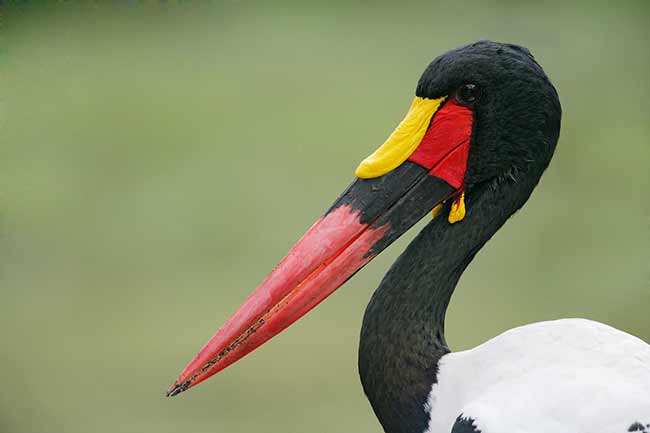

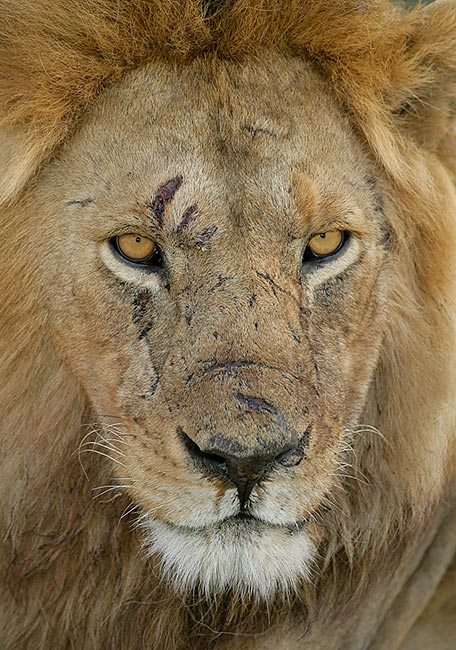
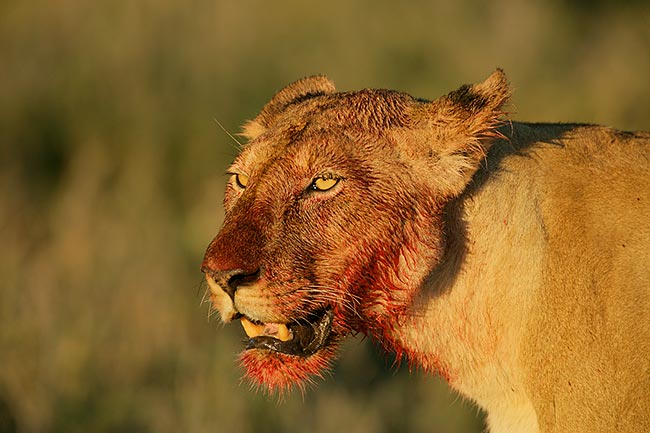
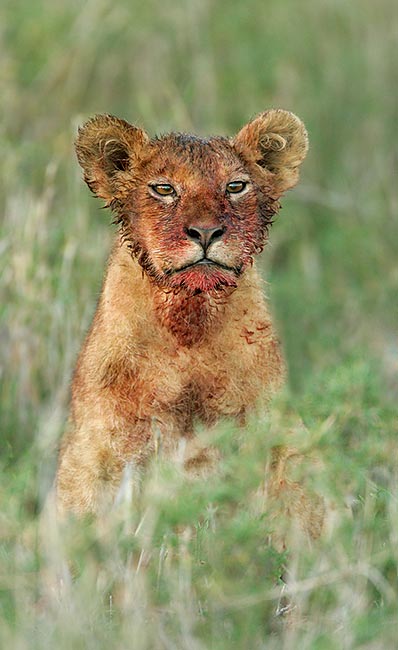
Next we were on to the amazing and seldom-visited Ndutu where the lion- and cheetah-fest got into full swing. We spent five nights at Ndutu and pretty much enjoyed excellent game drives twice each day. The highlights for me included two sessions with an 18-lion pride that included 8 cubs. These lions were with a zebra kill both mornings. (Lions do most of their hunting at night.) Aside from the lions, the group made great images of Lilac-breasted and European Rollers, Common Zebra, Maasai Giraffe, and Cheetah. Our last and once again spectacular stop was the famed Ngorongoro Crater where the highlights were the African Elephants (two of our five vans got to photographed the famed Big-Tusker) and, you-guessed-it, lots more lions. In addition most of the group had good chances with hippos, newborn Wildebeests, very young zebra foals, Abdim's Stork, and Grey-crowned Crane among others. On our next-to-last morning came upon a pair of hippopotami mourning the death of a tiny baby hippo. It was the saddest thing I have seen since my Ndutu zebra experience two years ago. (Wes and Patti Ardoin and I came upon a zebra stallion nuzzling his dead mare while attempting to fend off the vultures and hyenas. We stayed with it for several hours and eventually a hyena pulled the unborn young zebra from the mare; she had died during the birthing process.)
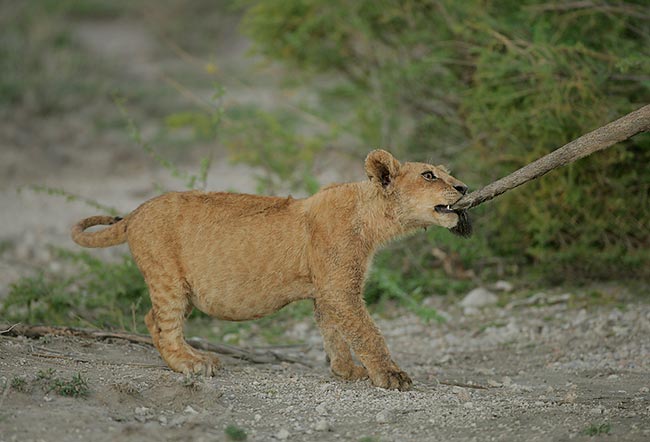
During our wrap-up slide show both Todd and I were blown away by the quality of the images presented by the group members. IPT veteran and good friend James S. White brought along his wife Linda and to his surprise she borrowed a 20 D body and a 400 DO lens from Hal DuPont. Linda would up making some truly great images. While digital does allow beginners to create good images almost out of the box (with just a bit of instruction) it was obvious to all that Linda White has some talent!
With my Antarctica trip coming up in January 2007, I will not be returning to Tanzania until 2008. Todd is running a Tanzania trip in February 2006 but it is already oversold. Our Kenya trip next August was sold out but two couples planning to travel together have cancelled so we have room for four more folks. As we have this safari thing pretty much down pat we expect the Kenya trip to fill quickly.
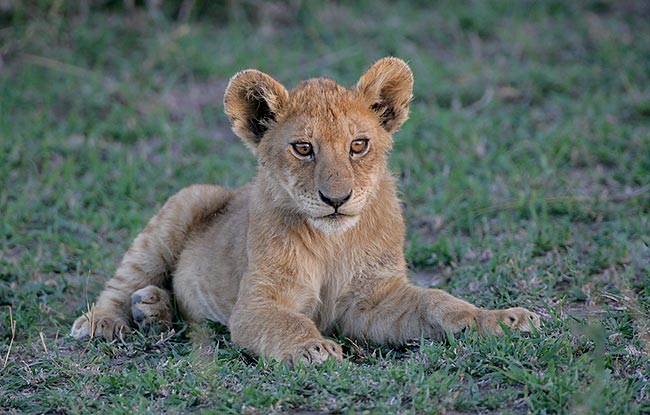
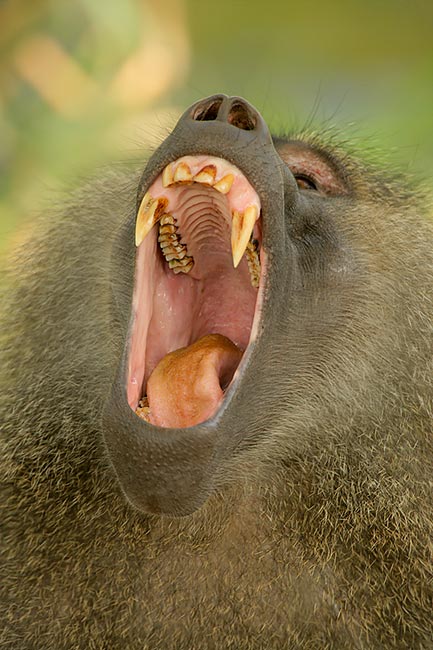
We have sold 59 of the sixty BLUBBs that we received from John Stanford. We have received only positive feedback so far. I will have 20 BLUBBS for sale at NANPA and we will be receiving 20 more from John before he and his wife head for Australia and New Zealand for six weeks after NANPA. He will not be sewing again until early April so if you would like to get your hands on a BLUBB before mid-April it would be best to pre-order one now so that you can get one of the final twenty that will be available soon.
BLUBBS are $100 (shipped empty, no beans included) plus $6 shipping and handling (US Priority Mail/signature required). If you would like additional BLUBB information please e-mail us at birdsasart@att.net and request same.
When I arrived in Tanzania I filled my BLUBB with 16 pounds of local beans and it was pretty much useless because of the configuration of the top of the van. I removed about 6 pounds of beans and voila, it was perfect for many uses. Filled, it could not fit over the railings atop the van. Partially emptied, it could be draped over the railing or even better, one of the flaps could be tucked in under the rail. The concave upper surface made a BLUBB-supported lens about 500 times more stable than one supported by a standard beanbag. Standard beanbags have convex surfaces. When you place a round lens barrel on a convex surface, the lens tends to rolls off to one side or the other. When you place a lens barrel on a concave surface, it stays put. Solidly. Most folks on the Photo-Safari came equipped with Todd-Pods, but Doug Holling brought a standard beanbag for his Nikon 200-400. Once I got him to try my BLUBB he purchased one from me on the spot.
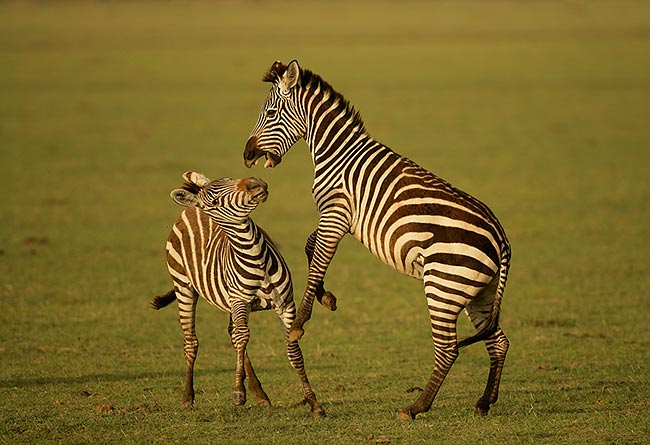
WORKING IN MANUAL MODE
As many folks are confused as to how to work in or set exposure compensation when working in Manual mode, I offer the following basic tutorial.
#1: When you work in Manual mode you select and set the shutter speed and you select and set the aperture. With my Canon cameras the default has you changing the shutter speed with your index finger dial and the aperture with the thumb wheel.
#2: After selecting Manual mode, point your camera at a scene or stationary subject and lock your tripod head so the framing remains constant. Next select and set the desired aperture. Then adjust the shutter speed until the analog scale in the viewfinder nulls out to zero. With Canon pro bodies this scale is laid out vertically along the right side of the viewfinder display (when you are working in horizontal format). With many of the pro-sumer bodies the analog scale is laid out horizontally at the bottom of the viewfinder display. The zero or null indicator is at the center of the analog scale. The three full stops above the null symbol (marked in 1/3-stop increments) indicate overexposure. The three full stops below the null symbol (also marked in 1/3-stop increments) indicate underexposure. If you change the aperture and you do not see the small square moving, check either the top or the bottom of the analog scale. You will note a small triangle at the top if you are way overexposed or a small triangle at the bottom if you are way underexposed. If the former, rotate the dial and choose faster shutter speeds, if the latter, choose slower shutter speeds. In either case, you will soon see the small square moving up or down the analog scale. At first, you will simply want to practice nulling the meter, that is, getting the small square to rest on the null symbol. This indicates that you have now set the metered exposure (as determined by the camera's Evaluative Metering system.
#3: When you work in Manual mode it is not possible to set exposure compensation. To come up with the exposure that you wish, simply change the aperture or shutter speed as above until the small square indicates the amount of over- or under-exposure that you desire. If you wish to work at +2 stops, you need adjust either the shutter speed or the aperture until the small square rests on the symbol that is two full stops above the null symbol. If you wish to underexpose by 1/3 stop, you need adjust either the shutter speed or the aperture until the small square rests on the symbol that lies just below the null symbol.
With a bit of practice you should quickly become comfortable whenever the need to work in Manual mode arises.
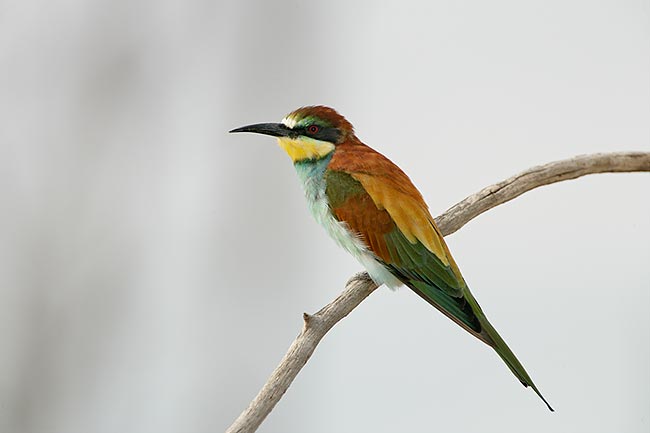
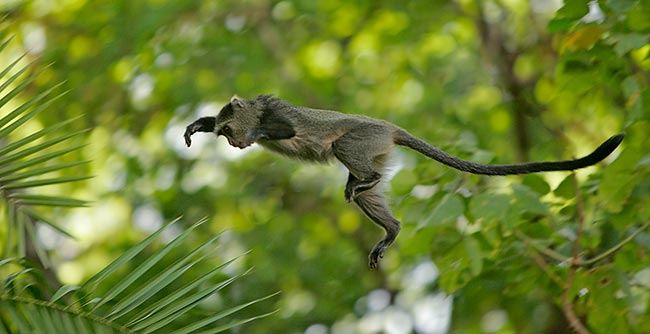
SAN DIEGO IPT KUDOS
Here are two e-mails that I received recently:
#1: Hi Artie,
Well, you did it again. After attending five IPTs I am still amazed by the number and variety of subjects that you put your groups on. I would never work as hard if I were out alone. As usual I came home with more quality images than I thought was possible. Hanging out with the other photographers was great and it only took me a week to recover from the sleep deprivation. The tremendous amount of education and opportunities that you crammed into 4 days is truly amazing. Thanks for yet another world-class outing. I ended up keeping the panning ground pod that I borrowed in San Diego. I will send a check to your office on Monday. See you at NANPA.
Jack Panzeca
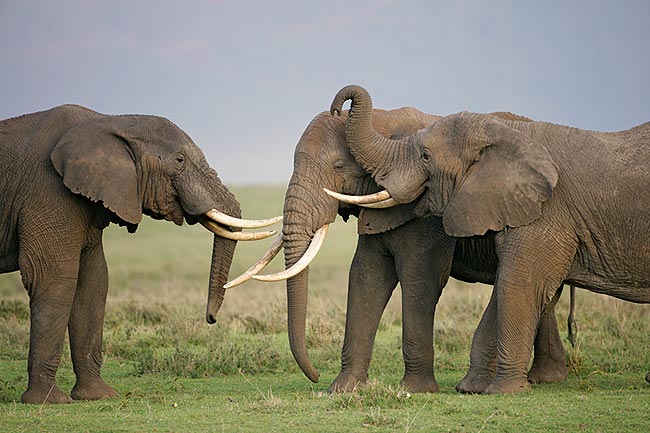
In BAA Bulletin 189, we proudly announced four Bosque IPTs for 2006. Soon after that we announced that the last two had to be cancelled because of my commitment to lead a very special Africa trip. I realized last week while talking to Janie Bullard that the Africa trip will run in late November 2007, not late November 2006. As a result, I am reverting to my original plan :
What can I say? I love this place. It makes such a great learning laboratory that I am scheduling four IPTs next year instead of the usual three. In addition, Ellen will be doing a Photoshop ITF Workshop after the 1st IPT (see below) and I am planning on doing a weekend BIRDS AS ART "The Art of Nature Photography; It Ain't Just Birds!" How-To Seminar in Albuquerque on the weekend of December 2-3.
Here are the dates and information for the four Bosque 2005 IPTs as well as some additional and relevant information.
Bosque #1: "The Fall Color IPT" NOV 14-16, 2006. Slide Program on the evening of NOV 13. 3-DAY: $929. Limit 14. Co-leader Ellen Anon. This IPT should feature a better chance for a day or two of the rare south winds that drastically improve flight photography and will definitely feature the brightest fall-color cottonwoods.
Ellen's 2006 Bosque In-The-Field Photoshop Workshop will be scheduled for NOV 17-18, 2006. Ellen's ITF Workshops have sold out, but only 100% of the time. Folks wishing to attend should sign up for either Bosque IPT #1 (above) or #2 (below).
Bosque #2: "The Pre-Thanksgiving IPT" NOV 19-21, 2006. Slide Program on the evening of NOV 18. 3-DAY: $929. Limit 14. Co-leader Ellen Anon. This and the next IPT have sold out for the past eight years. In 2006 I may once again be hosting a Thanksgiving day luncheon buffet. If it goes, folks will need to reserve a spot and pay in advance. Details TBA. Dinner will be strictly limited to 50 folks. This IPT will feature increasing numbers of geese and cranes with lots of great opportunities.
Bosque #3: "The Post-Thanksgiving IPT" NOV 25-27, 2006. Slide Program on the evening of NOV 24. 3-DAY: $929. Limit 14. Co-leader Ellen Anon. This IPT has sold out for the past eight years as it is scheduled on dates that I consider peak for Bosque.
Seminar: DEC 2-3, 2006. BIRDS AS ART "The Art of Nature Photography; It Ain't Just Birds!" How-To Weekend Seminar in Albuquerque, NM. Details TBA. Folks wishing to combine an IPT with the Seminar should sign up for either Bosque #3 (above) or Bosque #4 (below). Details TBA.
Bosque #4: "The Full Moon IPT" DEC 4 (mid-day) through DEC 7 (mid day), 2006. 3-DAY: $929. Slide Program mid-day on DEC 4. This IPT includes a half day of photography on the 4th, two full days of photography on the 5th and 6th, and a final half day on December 7th. Limit 14. Co-leader to be announced. This IPT has been scheduled to maximize the opportunities to include the rising and setting full (DEC 5) and near-full moon in your images. There will be lots of the usual chances as well, and this time period has provided more than its share of spectacular sunrises and sunsets over the years.
To register for any of the Bosque IPTs above, you can send a $200 deposit check made out to "Arthur Morris" to us at: BIRDS AS ART, 4041 Granada Drive, Indian Lake Estates, FL 33855, send us a Paypal (use any Paypal link on our web site), or call 863-692-0906 with your credit card info.
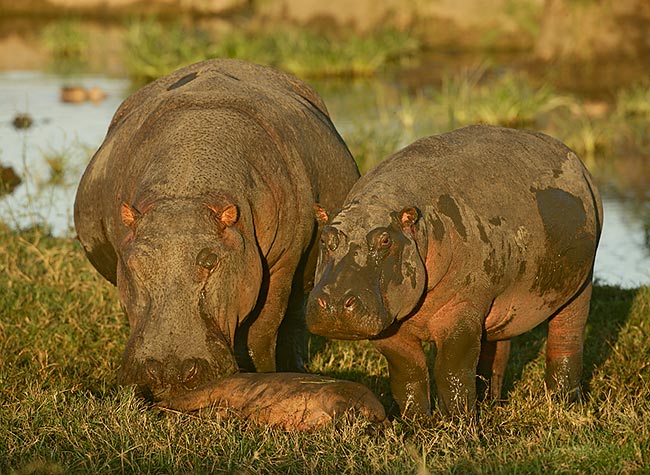
LAKE MARTIN, LA SPOONBILLS, APR 8-10 (5 openings) & 28-30, 2006 (6 openings) 3 -DAY: $949 (Limit 12) ROSEATE SPOONBILL (& GREAT EGRET) ROOKERY IN CYPRESS SWAMP; COURTSHIP & NEST BUILDING. 500 or 600mm LENSES RECOMMENDED, RENTALS AVAILABLE. ALSO GREEN & LITTLE BLUE HERONS, BOTH NIGHT-HERONS, SUNRISE SCENIC; FLOWERS. INCLUDES A COMPLIMENTARY CRAWFISH ETOUFFE DINNER: HOSTS: WES & PATTI ARDOIN
ST. AUGUSTINE ALLIGATOR FARM IPT MAY 12-14, 2006. 2 1/2 DAY IPT (Limit: 12, 9 openings): $649 HERON AND EGRET ROOKERY. NESTING GREAT EGRETS WITH CHICKS, NESTING SNOWY AND CATTLE EGRETS AND TRICOLORED HERONS. COURTSHIP BEHAVIORS, COPULATIONS, EGGS, NESTS AND POSSIBLY TINY CHICKS. INCLUDES TWO CLASSROOM SESSIONS.
GALAPAGOS PHOTO CRUISE/YACHT BELUGA JUNE 30-JULY 7, 2006. E-MAIL FOR DETAILS. Wait list only.
KENYA FLY-DRIVE PHOTO SAFARI, AUG 2006. SAMBURU, MAASAI MARA, AND MORE. Leave the US AUG 21. Amsterdam to Nairobi: AUG 22. Amsterdam to US: SEPT 7. $9499 per person (round trip airfare to Kenya not included). Please e-mail for itinerary. 4 slots left.
BOSQUE IPTS: please see same above.
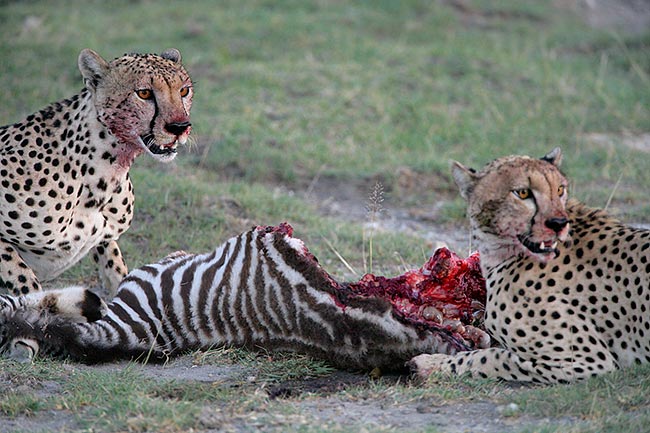
WIMBERLEY HEAD V2s SHIPPED
We received our first twenty Version Two Wimberley heads and shipped them to the first twenty lucky folks on our list. We are still accepting pre-orders. Your card will not be billed until your head is shipped. It will be a tough item to get your hands on for a month or two until supply catches up with the high demand... We are expecting our second batch soon.
In the next Bulletin, I shall include a complete report on this brand new head.
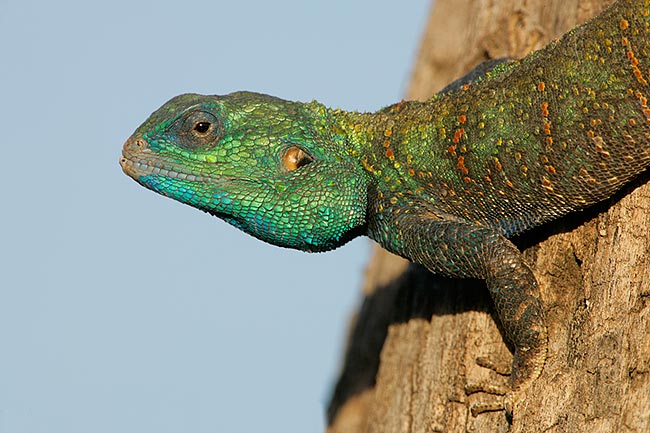
Best and love and great picture-making to all,
artie
Note: Arthur Morris has been a Canon contract photographer since 1994 and continues in that role today. Hunt's Photo of Boston, MA is a BAA sponsor as it Delkin Devices. Back issues of all BAA Bulletins are archived in the Bulletin Archives which may be accessed from the home page at www.birdsasart.com